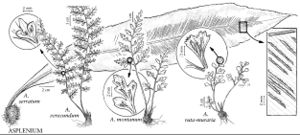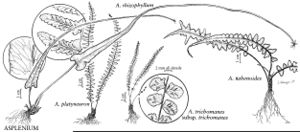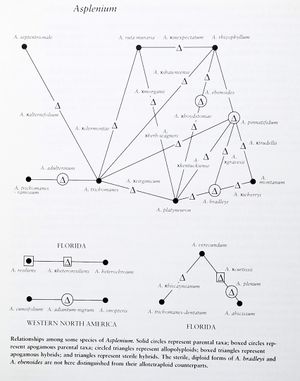familyAspleniaceae
genusAsplenium
Show Lower Taxa
Asplenium abscissum, Asplenium adiantum-nigrum, Asplenium adulterinum, Asplenium auritum, Asplenium bradleyi, Asplenium cristatum, Asplenium dalhousiae, Asplenium ebenoides, Asplenium exiguum, Asplenium heterochroum, Asplenium monanthes, Asplenium montanum, Asplenium palmeri, Asplenium pinnatifidum, Asplenium platyneuron, Asplenium plenum, Asplenium pumilum, Asplenium resiliens, Asplenium rhizophyllum, Asplenium ruta-muraria, Asplenium scolopendrium, Asplenium septentrionale, Asplenium serratum, Asplenium trichomanes, Asplenium trichomanes-dentatum, Asplenium trichomanes-ramosum, Asplenium verecundum, Asplenium vespertinum, Asplenium ×biscayneanum, Asplenium ×curtissii, Asplenium ×heteroresiliens
Asplenium
Sp. Pl. 2: 1078. 1753; Gen. Pl. ed. 5, 485, 1754.
Common names: Spleenwort
Etymology: Greek splen, spleen thought by Dioscorides to be useful for treating spleen diseases
Treatment appears in FNA Volume 2.
Revision as of 00:25, 30 July 2020 by imported>Volume Importer
Roots fibrous, not proliferous or proliferous and producing tiny plantlets. Stems erect, rarely long-creeping; scales basally attached, clathrate. Petioles not articulate. Blades 1–4-pinnate, of diverse size and shape. Indusia present. x = 36.
Distribution
Worldwide
Discussion
Species ca. 700 (28 species, 3 nothospecies in the flora).
Selected References
None.
Lower Taxa
Asplenium abscissum, Asplenium adiantum-nigrum, Asplenium adulterinum, Asplenium auritum, Asplenium bradleyi, Asplenium cristatum, Asplenium dalhousiae, Asplenium ebenoides, Asplenium exiguum, Asplenium heterochroum, Asplenium monanthes, Asplenium montanum, Asplenium palmeri, Asplenium pinnatifidum, Asplenium platyneuron, Asplenium plenum, Asplenium pumilum, Asplenium resiliens, Asplenium rhizophyllum, Asplenium ruta-muraria, Asplenium scolopendrium, Asplenium septentrionale, Asplenium serratum, Asplenium trichomanes, Asplenium trichomanes-dentatum, Asplenium trichomanes-ramosum, Asplenium verecundum, Asplenium vespertinum, Asplenium ×biscayneanum, Asplenium ×curtissii, Asplenium ×heteroresiliens
Key
| 1 | Blades simple, pinnatifid, or forked (sometimes with free pinnae at base), not pinnate throughout. | > 2 |
| 1 | Blades pinnate throughout or pinnatifid only in distal 1/3, pinnae undivided to 1–3-divided. | > 8 |
| 2 | Blades less than 2–3 mm wide, linear, frequently forking or with 1–3 small, narrow projections. | Asplenium septentrionale |
| 2 | Blades more than 10 mm wide, linear-lanceolate to lanceolate, if lobed, segments resembling adnate pinnae. | > 3 |
| 3 | Veins anastomosing to form areoles; blades rooting at tip. | Asplenium rhizophyllum |
| 3 | Veins free; blades with apical buds or not but not rooting at tip. | > 4 |
| 4 | Blades simple, linear to oblanceolate. | > 5 |
| 4 | Blades pinnatifid, elliptic, lanceolate, to deltate. | > 6 |
| 5 | Blades cordate at base; roots not proliferous. | Asplenium scolopendrium var. americanum |
| 5 | Blades tapered at base; roots proliferous. | Asplenium serratum |
| 6 | Petioles 1 cm or less, dull; stem scales 0.6–1 mm wide, sparsely denticulate. | Asplenium dalhousiae |
| 6 | Petioles 1–10 cm, lustrous; stem scales less than 0.5 mm wide, entire. | > 7 |
| 7 | Petioles dark-pigmented only at base; blade narrowly deltate. | Asplenium pinnatifidum |
| 7 | Petioles and proximal midrib darkly pigmented abaxially; blade oblong- lanceolate. | Asplenium ebenoides |
| 8 | Blades 2–4-pinnate, with only largest pinnae divided to all pinnae divided. | > 9 |
| 8 | Blades 1-pinnate, pinnae undivided (except in some individuals of A. pumilum). | > 18 |
| 9 | Blades deltate-ovate, with 2–5 pairs of pinnae; pinnae generally deltate-ovate to obdeltate, rarely lanceolate to narrowly elliptic; color in living plants dull bluish green. | Asplenium ruta-muraria |
| 9 | Blades ovate-lanceolate to linear, with 5–20 pairs of pinnae; pinnae linear to oblong; color in living plants shiny green. | > 10 |
| 10 | Delicate root proliferations usually present (commonly buried in mossy soil in crevices, but enabling clone formation); damp, shaded limestone; Florida. | > 11 |
| 10 | Delicate root proliferations absent or rare; mainly rock crevices; plants not in Florida. | > 15 |
| 11 | Spores uniform and normal. | > 12 |
| 11 | Spores of different sizes and shapes, malformed (irregular in size and shape). | > 13 |
| 12 | Blades oblong-lanceolate, mostly 2- pinnate; pinnae lanceolate to oblong- lanceolate. | Asplenium cristatum |
| 12 | Blades narrowly lanceolate, 2–3- pinnate; pinnae ovate to ovate- deltate. | Asplenium verecundum |
| 13 | Blades linear-lanceolate, s Florida. | Asplenium ×biscayneanum |
| 13 | Blades oblong-lanceolate, c Florida. | > 14 |
| 14 | Medial pinnae pinnate throughout; pinnules mostly deeply notched apically. | Asplenium ×curtissii |
| 14 | Medial pinnae pinnate only in proximal 1/2; pinnules mostly shallowly notched apically. | Asplenium plenum |
| 15 | Buds at blade, pinna, and pinnule apices minute, scaly, dormant; Arizona. | Asplenium exiguum |
| 15 | Buds absent; foothills and mountains in e United States and s Rocky Mountains. | > 16 |
| 16 | Petioles all pale green except at base. | Asplenium montanum |
| 16 | Petioles dark reddish brown. | > 17 |
| 17 | Blades lanceolate to linear- lanceolate, 1–2-pinnate; proximal pinnae often somewhat reduced; e United States foothills and mountains. | Asplenium bradleyi |
| 17 | Blades deltate-ovate to deltate- lanceolate, 2–3-pinnate; proximal pinnae usually largest; s Rocky Mountains. | Asplenium adiantum-nigrum |
| 18 | Pinna pairs 1–2(–4); blades ovate-deltate, with fine nonglandular hairs on veins. | Asplenium pumilum |
| 18 | Pinna pairs 5–35; blades mainly oblong to lanceolate, usually with glandular hairs or narrow hairlike scales on veins or blades glabrous. | > 19 |
| 19 | Pinnae with conspicuous basal auricles overlapping rachis; sori inframedial; leaves ± dimorphic, upright and tall, or spreading and short; plants often terrestrial. | Asplenium platyneuron |
| 19 | Pinnae bases not overlapping rachis; sori medial to supramedial; leaves monomorphic; plants mainly on rock (epiphytic in A. auritum). | > 20 |
| 20 | Blades mostly 4–9 cm wide, linear- lanceolate to oblong-lanceolate. | > 21 |
| 20 | Blades mostly less than 3 cm wide, mainly linear. | > 22 |
| 21 | Blades linear-lanceolate, to 35 cm; pinna pairs 10–22, base with conspicuous acroscopic auricle; epiphytic on tree trunks. | Asplenium auritum |
| 21 | Blades oblong to oblong-lanceolate, to 20 cm; pinna pairs 4–8, base with or without small acroscopic auricle; on mossy limestone. | Asplenium abscissum |
| 22 | Sori 1(–3), mainly confined to basiscopic side of strongly asymmetric pinnae. | Asplenium monanthes |
| 22 | Sori 4–10, on both sides of costa of nearly symmetric pinnae. | > 23 |
| 23 | Blade apex prolonged into whiplike extension of rachis terminating in bud. | Asplenium palmeri |
| 23 | Blade apex not prolonged, terminal bud absent. | > 24 |
| 24 | Pinnae ovate, oblong-ovate, to rhombic, mainly 4–7 mm, length 1–2 times width. | > 25 |
| 24 | Pinnae oblong-lanceolate to oblong, mainly 6–10 mm, length 3–5 times width. | > 28 |
| 25 | Rachises dark reddish brown throughout. | Asplenium trichomanes |
| 25 | Rachises dark in proximal 1/3–2/3 or only at base. | > 26 |
| 26 | Rachises dark in proximal 1/3–2/3; pinna margins entire to shallowly crenate. | Asplenium adulterinum |
| 26 | Rachises dark only at base; pinna margins dentate-crenate. | > 27 |
| 27 | Pinnae with basiscopic 1/2 much reduced; blades mainly less than 1 cm wide; n North America. | Asplenium trichomanes-ramosum |
| 27 | Pinnae nearly symmetric; blades mainly more than 1 cm wide; s Florida. | Asplenium trichomanes-dentatum |
| 28 | Pinna margins deeply lobed, especially acroscopic and distal margins, cut 1/3 or more distance from margin to costa; s California. | Asplenium vespertinum |
| 28 | Pinna margins nearly entire or shallowly crenate- dentate; se United States to e Arizona. | > 29 |
| 29 | Pinna margins nearly entire; sori supramedial; spores 32; widespread in s United States. | Asplenium resiliens |
| 29 | Pinna margins ± shallowly crenate- dentate; sori medial to inframedial; spores 32 or 64; local in se United States. | > 30 |
| 30 | Pinna margins shallowly crenulate; auricle present at pinna base; veins obscure; spores 32 per sporangium. | Asplenium ×heteroresiliens |
| 30 | Pinna margins serrate to crenate; auricle rudimentary or absent at pinna base; veins evident; spores 64 per sporangium. | Asplenium heterochroum |
... more about "Asplenium"
interrupted +
vertical +
1-4-pinnate +
diverse +
Spleenwort +
Worldwide +
green +
surficial +
cordate +
tiny +
spreading +
Present +
absent +
monomorphic +
dimorphic +
taller +
erect +
not articulate +
c--shaped +
tiny +
Sp. Pl. +
1754 +
fibrous +
clathrate +
attached +
few +
less lunate;linear +
monolete +
long-creeping +
erect +
Asplenium +
Aspleniaceae +
genus +
anastomosing +
free +
terrestrial +
epiphytic +


